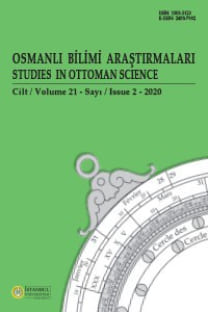El-Cezerî’nin Batar Türden Bir Süreölçeri (Tarcahâr)
In ancient Egypt the priests needed to tell the time during the night, so that the rites and sacrifices could be duly performed. On clear nights they could use the stars to designate the hours, but they needed a clock when it was cloudy. The Egyptians had a waterclock for this purpose in their temples which made use of the flow of water through a fine orifice for time regulation. Since the Egyptians used a linear scale on the inside of their clocks to mark the hours, the bottom of the vessel had to have a smaller crosssectional area then the top.The submersive float is another type of time measuring device. It was used in Antiquity to determine a given time duration. A vessel with a fine ori fice on the bottom is put on a water surface. When the vessel sinks one knows that a predetermined time has passed. If desired, one can pour out the water and put the vessel for a second time on the water surface. If the vessel crosssection is equal along the height of the vessel the sinking rate is constant, and time scale generally marked on the in or outside wall of the vessel is linear. This kind of time devices were in use from Antiquity till the beginning of twentieth century to determine the lecturing time of a speaker or the irrigation time in agriculture.The most important work on engineering written before the Renaissance was the book on mechanics Kitab alhiyal of Ibn alRazzâz alJazari. It was composed in Diyarbakır (present day Turkey) in 1206. There are 50 different devices, such as water clocks, trick vessels, liquid dispensers, and phlebotomy measuring instruments, fountains, musical automata, and waterraising ma chines, as well as a submersive float (tarjahar) like the one described above. This is a 1½ spanlong (app.35 cm) sinking vessel in the form of an elegant boat in which a boatman stands and plays a flute. The boat put on water surface sinks after one hour and the boatman informs the end of the hour by blowing a tone.In this paper first, a detailed mathematical model of the outpouring and sinking process is given. Secondly, a calculation method is developed and applied for the orifice diameter in the determination of the alJazari type time keeping vessel.
Anahtar Kelimeler:
el-Cezeri, Kitab el-Hiyel, otomatlar, tarcahar, zaman ölçme
A sinkingtype timekeeping vessel (tarjahar) of alJazarî
In ancient Egypt the priests needed to tell the time during the night, so that the rites and sacrifices could be duly performed. On clear nights they could use the stars to designate the hours, but they needed a clock when it was cloudy. The Egyptians had a waterclock for this purpose in their temples which made use of the flow of water through a fine orifice for time regulation. Since the Egyptians used a linear scale on the inside of their clocks to mark the hours, the bottom of the vessel had to have a smaller crosssectional area then the top.The submersive float is another type of time measuring device. It was used in Antiquity to determine a given time duration. A vessel with a fine ori fice on the bottom is put on a water surface. When the vessel sinks one knows that a predetermined time has passed. If desired, one can pour out the water and put the vessel for a second time on the water surface. If the vessel crosssection is equal along the height of the vessel the sinking rate is constant, and time scale generally marked on the in or outside wall of the vessel is linear. This kind of time devices were in use from Antiquity till the beginning of twentieth century to determine the lecturing time of a speaker or the irrigation time in agriculture.The most important work on engineering written before the Renaissance was the book on mechanics Kitab alhiyal of Ibn alRazzâz alJazari. It was composed in Diyarbakır (present day Turkey) in 1206. There are 50 different devices, such as water clocks, trick vessels, liquid dispensers, and phlebotomy measuring instruments, fountains, musical automata, and waterraising ma chines, as well as a submersive float (tarjahar) like the one described above. This is a 1½ spanlong (app.35 cm) sinking vessel in the form of an elegant boat in which a boatman stands and plays a flute. The boat put on water surface sinks after one hour and the boatman informs the end of the hour by blowing a tone.In this paper first, a detailed mathematical model of the outpouring and sinking process is given. Secondly, a calculation method is developed and applied for the orifice diameter in the determination of the alJazari type time keeping vessel.
Keywords:
automata, alJazari, Kitab alHiyal, time measuring, tarjahar,
___
- -
- ISSN: 1303-3123
- Yayın Aralığı: Yılda 2 Sayı
- Başlangıç: 1995
- Yayıncı: İstanbul Üniversitesi Edebiyat Fakültesi
Sayıdaki Diğer Makaleler
Bizans ve Osmanlı Döneminde Selanik’te Sağlık ve İlaç
Mavroyeni Paşa, Dr. John Kirk ve Mehmet Ali Kâğıtçı hakkında notlar
Bursa Ziraat Cemiyeti (1927) ve Yayını Asrî Çiftçi
Miken Arabalarının Teknoloji Tarihi Açısından Değerlendirilmesi
Gaye ŞAHİNBAŞ-ERGİNÖZ, Atilla BİR
Osmanlı Basınında 1865 Kolera Salgını, İstanbul Sağlık Konferansı ve Mirza Malkom Han
Yunanistan’da Bilim Tarihi Çalışmaları
El-Cezerî’nin Batar Türden Bir Süreölçeri (Tarcahâr)
